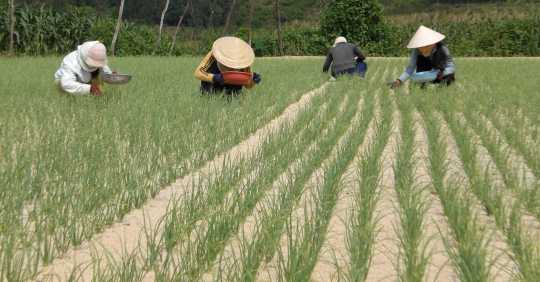Dramatic change thanks to plant transformation
A son of his hometown of Cat Hai (Phu Cat District, Binh Dinh) is the poet Khong Vinh Nguyen, who once wrote: “The sun burns the sand and the yam, I eat the stomach of a homeland”. These two verses illustrate the aridity and poverty of the landscape, which is both a coastal community and a mountainous region. But that was earlier…
So far, the main income of the people of Cat Hai is still agricultural production, the rice cultivation area is terraced fields, so there is a high degree of erosion and leaching. The irrigation system has not met the production needs, the main source of irrigation water uses groundwater, so the efficiency is very low.
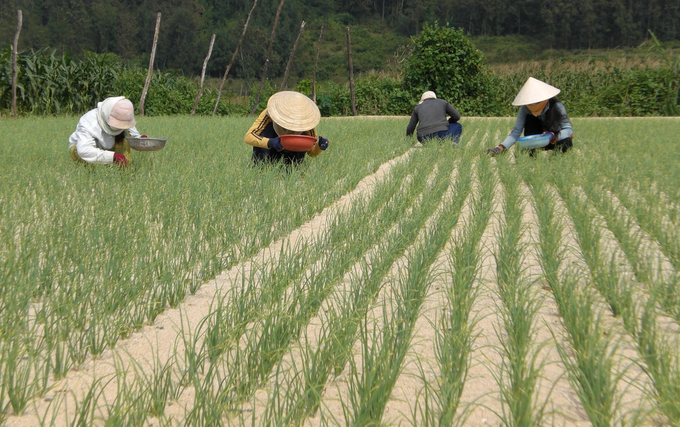
Onions are a crop that brings very high economic efficiency to the people of sandy soils in Cat Hai Municipality (Phu Cat District, Binh Dinh). Photo: VDT
When the crop restructuring policy was not implemented, Cat Hai was the poorest community in Phu Cat District, and people’s lives here were extremely difficult. Rice plants do not have enough food. Only 45 ha can produce 3 rice crops per year thanks to the water source from Tan Thang Irrigation Reservoir, the remaining rice cultivation areas cannot be actively irrigated, so they can only produce 2 rice crops per year.
The winter-spring harvest is precarious, because it is often damaged by heavy rains at the beginning of the harvest, when the rice blooms again, it meets the Korean weather, so the yield is very poor, only about 30-35 quintals/ ha , even in some years it gets lost due to the weather. For dry rice, the harvest depends on the water of heaven whether it is good or bad, the yield is only 18-20 quintals/ha. Therefore, poverty always attaches to the people of Cat Hai.
Mr. Do Hoang Phong, vice chairman of the Cat Hai Township People’s Committee, said that people’s lives have improved since the town introduced the crop structure change policy. Up to now, the total converted area in Cat Hai township is 384/1,241 ha, which is 30.9% of the cultivated area. The area was mainly developed from the foot of the inefficient paddy cultivation field to the production of upland crops of high economic value such as onions, peanuts, peppers, sesame…
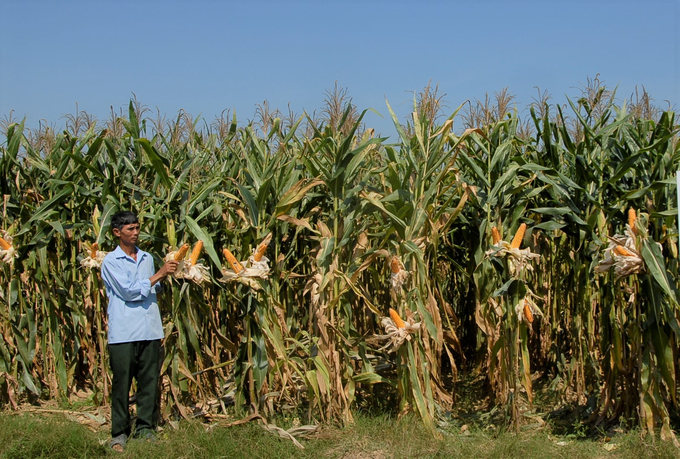
Corn is also a crop chosen by Binh Dinh farmers in the process of crop restructuring. Photo: VDT
“Thanks to the synchronous application of technical progress to production, the upland crops produced on converted paddy fields have high yields, and the income value increases 4-5 times compared to rice production. The income of onions is higher than that of rice by 114.3 million VND/ha; Peanuts are higher than 36.3 VND/ha; Chili crops are more than 192 million VND/ha,” shared Mr. Phong.
Currently, Cat Hai is known for its intensive farming, crop rotation and crop rotation formulas that bring very high economic value per unit of acreage. For example: winter-spring harvest – summer harvest – winter harvest in addition to corn harvest for income up to nearly 500 million VND/ha/year. Or like the winter-spring chili crop and the summer season chili plus beans for the autumn crop for an income of 475 million VND/ha/year. Or the winter-spring crop – summer beans and the winter crop in addition to the corn crop for an income of 416.8 million VND/ha/year. Winter-Spring Harvest – Summer Harvest – Autumn Liturgy bring an income of VND 416.8 million/ha/year.
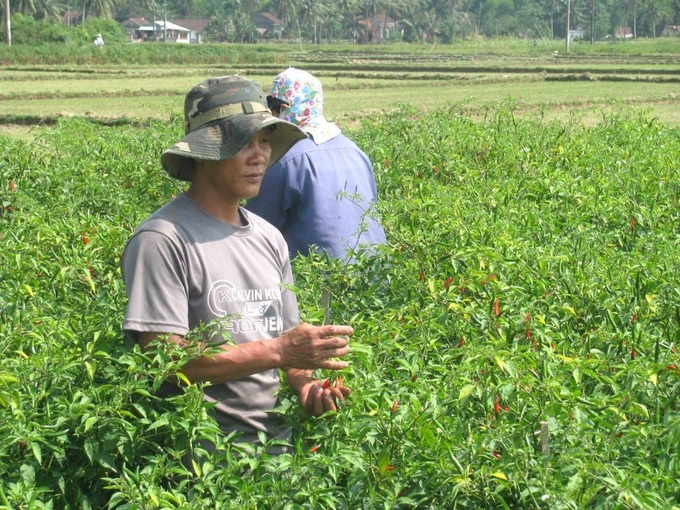
Previously inefficient crop rotation models on sandy soils are now generating half a billion Dong/year. Photo: VDT
In addition, beans for winter-spring liturgy – summer harvest and winter harvest – bring in income of VND 416.8 million/ha/year. Winter-spring lychee beans – summer lychee beans and autumn lychee beans bring in income of VND 227.3 million/ha/year. Spring Harvest – Summer Harvest and Winter Harvest yield 344.7 million VND/ha/year. Winter spring rice, summer sesame and autumn harvest bring in income of VND 217.3 million/ha/year.
“With the above production formulas, the land use coefficient in Cat Hai increased by 2.7 times, which helped increase the average income per hectare of cultivated area to more than VND 290 million, the average income per person currently reaches 47.3 million VND/year. up to VND20.5 million compared to 2015,” said Mr. Do Hoang Phong, vice chairman of the Cat Hai Municipality People’s Committee.
“In the past, the Cat Hai community has worked with the South Central Coast Institute of Agricultural Science and Technology to produce and test peanut and pilgrim cultivars that were selected by the institute and then mass-produced. Since then, the current peanut yield has averaged 35.8 quintals/ha,” said Mr. Do Hoang Phong, vice chairman of the Cat Hai Township People’s Committee.
Poor sandy soil produces the highest yield of peanuts in the country
Cat Hiep, a place which the people of Binh Dinh could first imagine as being located immediately on the dry sandy land to the west of Phu Cat district. The land that hides poverty lies beneath the vast sands. In summer, when you walk barefoot, you only get “mature” skin on your feet because the sun heats every grain of sand. The land is so rough but there is no irrigation system in the area so the farmers don’t know how to produce.
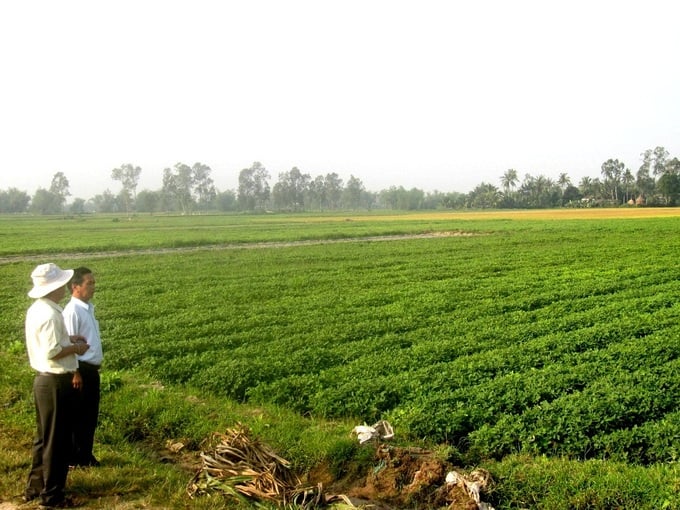
The peanut is a key crop in the restructuring of cultivation in Cat Hai and Cat Hiep communes (Phu Cat district, Binh Dinh). Photo: VDT
In the past, on Cat Hiep’s land, there were only cashew and cassava trees that could “stand”, but only “stand”, no trees could grow because the soil had no nutrients and no water to irrigate. The cashew tree is bare and will not bear fruit; Noodles are lean, “bony” isn’t much better. But because they don’t know what to plant, they put the seeds in the ground so they can harvest as much as possible.
According to the picture of Mr. Luong Van Khoa, Deputy Head of Department of Agriculture and Rural Development of Phu Cat District, Cat Hiep used to be dominated by cassava, with one harvest per year. Rice can only be cultivated in the winter-spring harvest, but it is very precarious because there is no water for irrigation, in the dry season a small area can be sown and then left to the sky, the harvested rice cannot be eaten without seeds.
According to Mr. Dao Van Chung, vice chairman of the Cat Hiep Township People’s Committee, in the past, when the Van Phong and Thuan Ninh irrigation canal system had not yet arrived in the township, Cat Hiep Township had only 2 dams and the rice harvest. In winter and spring, farmers have to dig holes and dig ponds to water rice. Agricultural land is not half the size it is today.
In 2012, the waters of the Dinh Binh and Thuan Ninh Lakes reached Cat Hiep, about 300 ha of cashew acreage and previously inefficient noodle-growing areas, farmers switched to cultivating peanuts (peanuts) interspersed with noodles. Currently, there are 150 hectares of wet rice production in Cat Hiep, and the main crop is peanuts, with an annual production area of 850 hectares, of which the winter-spring harvest adds 750 hectares with noodles, and the summer-autumn harvest adds another 100 hectares.
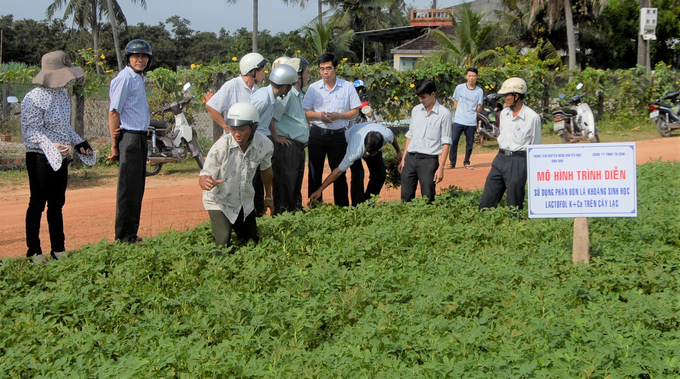
Cat Hiep farmers have actively applied new technological advances, putting what is believed to be the country’s highest peanut yield straight into the poor sandy soil. Photo: VDT
“Growing peanuts mixed with pasta is very effective. Every year in mid-December, farmers on high barefoot sow early peanuts, and low barefoot have to wait until late December to sow seeds to avoid flooding. Planting peanuts with noodles 3 months later is harvesting peanuts. After the peanuts are pulled out, people focus on caring for the cassava plants. In the later stage, the cassava plant “eats” the fertilizer in the soil, which people previously fertilized with peanuts, so it grows very strongly, 5-6 months later the noodles are harvested. So the farmers get money from two crops with the same bare foot,” said Mr. Dao Van Chung, vice chairman of the Cat Hiep Township People’s Committee.
Speaking about peanuts, Mr. Chung said he couldn’t finish the story. Because Mr. Chung is not only a community leader but also a real farmer, so he understands the benefits of peanuts for the farmers here. Now farmers in Cat Hiep have heard that the peanut yield of 40 quintals/ha, equivalent to 200 kg/sao (500 m2), is pouty and low, while it is the yield that peanut farmers everywhere dream of. For example, Mr. Chung takes care of both water and housework, but produces peanuts with a yield of 50-52 quintals/ha, in Cat Hiep municipality there are people who produce peanuts with a yield of up to 70 quintals/ha.
The main source of income for Cat Hiep farmers is cash crops. Some people grow peanuts in the winter-spring crop followed by 2 crops of corn (maize) or 1 crop of corn and another crop of peanuts. With a price of 25,000 VND/kg and an average yield of 50 quintals/ha, the peanut farmers in Cat Hiep earn 125 million VND/ha after 3 months, minus all costs, they also make a profit of at least 60 million VND/ha. Then people can harvest noodles from the same area and have more income. Adding up the net profits from peanuts and noodles, each crop of 1 ha of land, Cat Hiep farmers pocket almost 100 million VND in their “pocket”. A dream figure of a hardland farmer!

Currently, 98% of the peanut (peanut) acreage in Cat Hiep Township is actively irrigated with automatic baits. Photo: VDT
Since 2006, Binh Dinh has started to transform the plant structure. Over the years, this province has implemented policies to convert tens of thousands of hectares of inefficient rice land into upland crops, resulting in income many times higher. In addition, converting dried fruit to rice land saves water for irrigation, crop rotation helps improve soil, and limits pests and diseases…
In 2023, Binh Dinh applied to the Ministry of Agriculture and Rural Development to convert 1,775 hectares, of which 1,735 hectares were converted to upland crops, 36 hectares to permanent crops and 4 hectares to rice combined with aquaculture. At the same time, Binh Dinh promulgated guidelines to promote plant structure transformation, support technology transfer through appropriate models…

